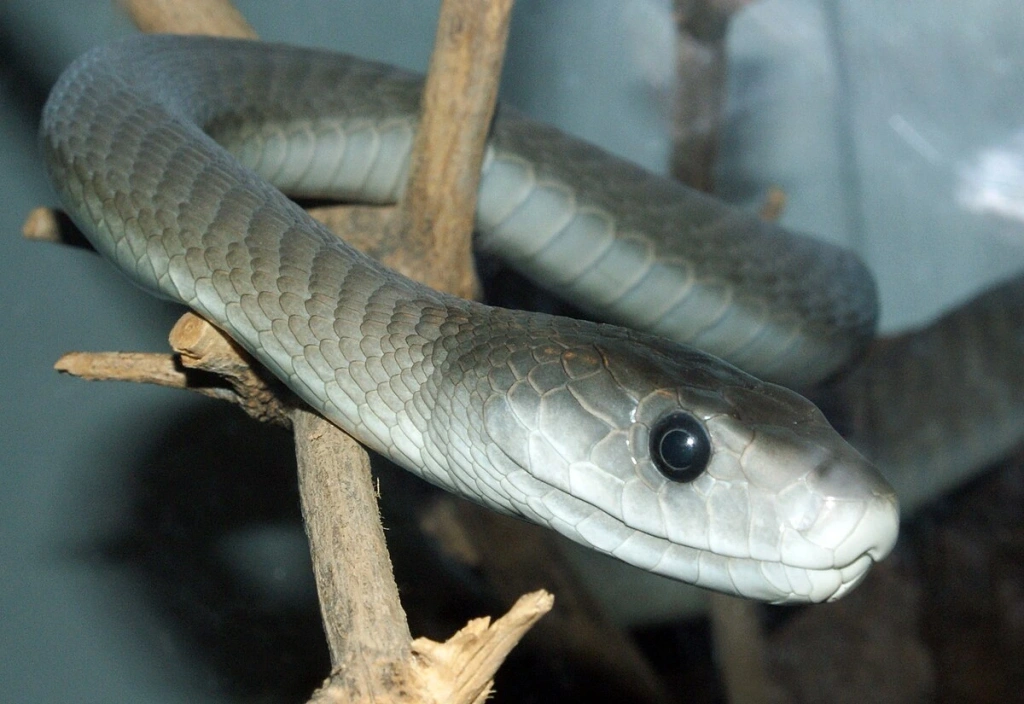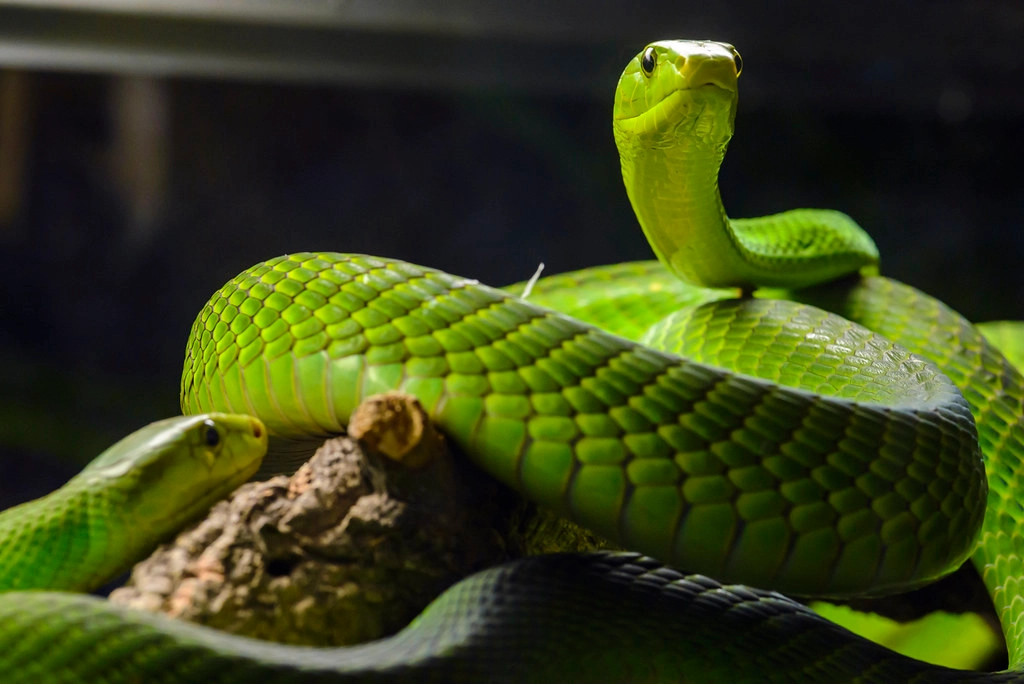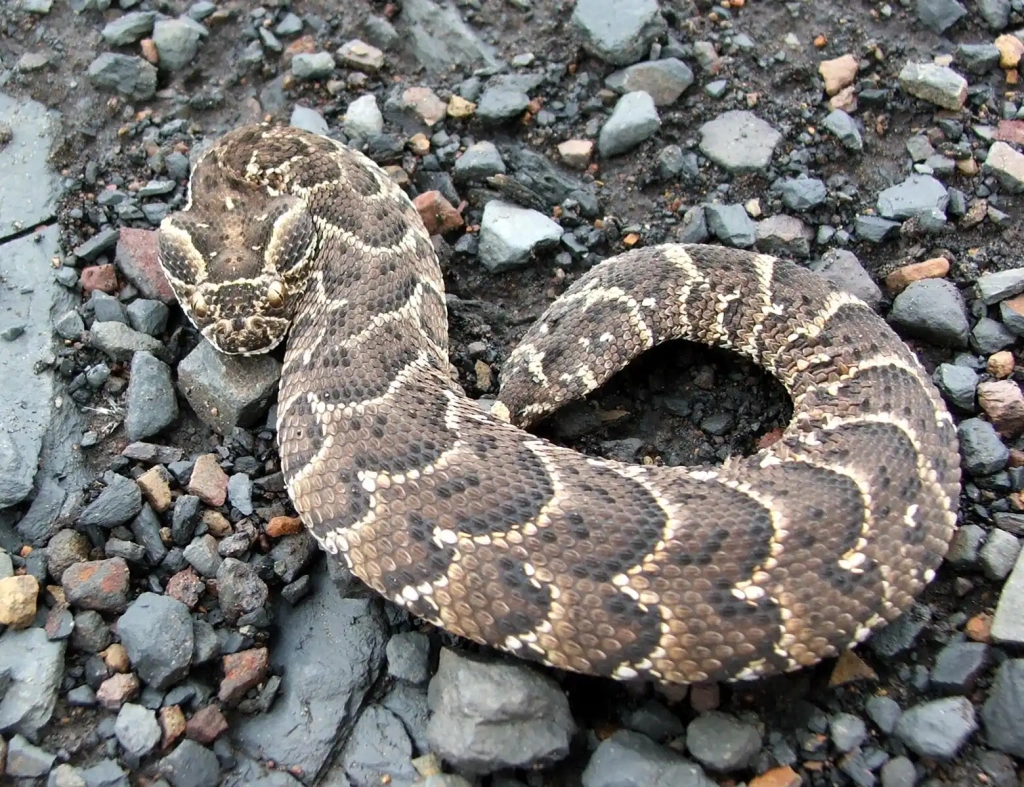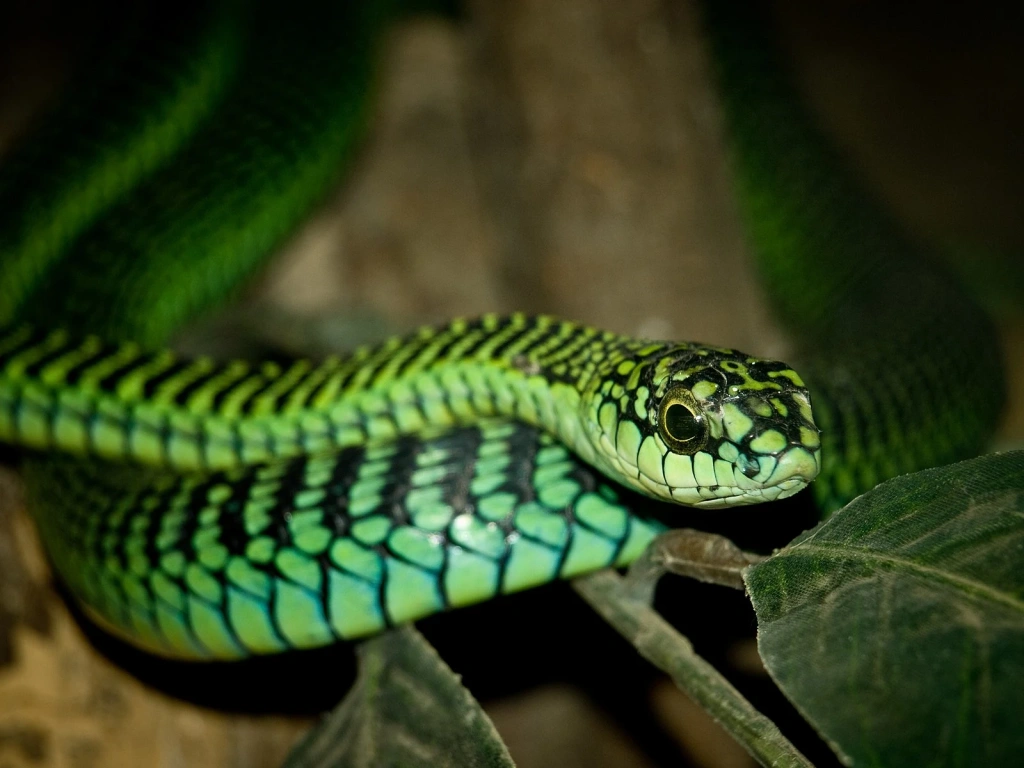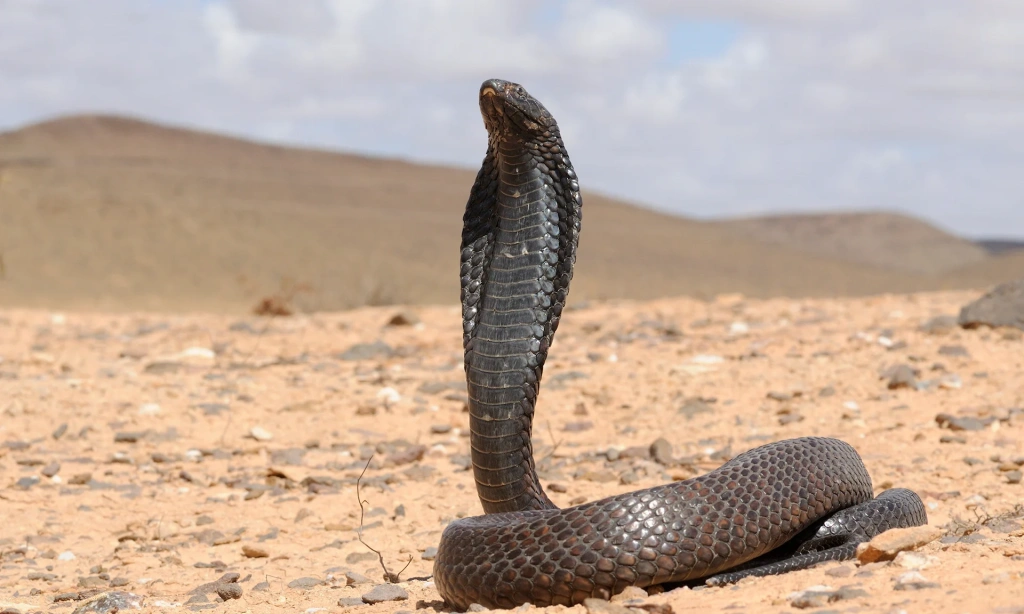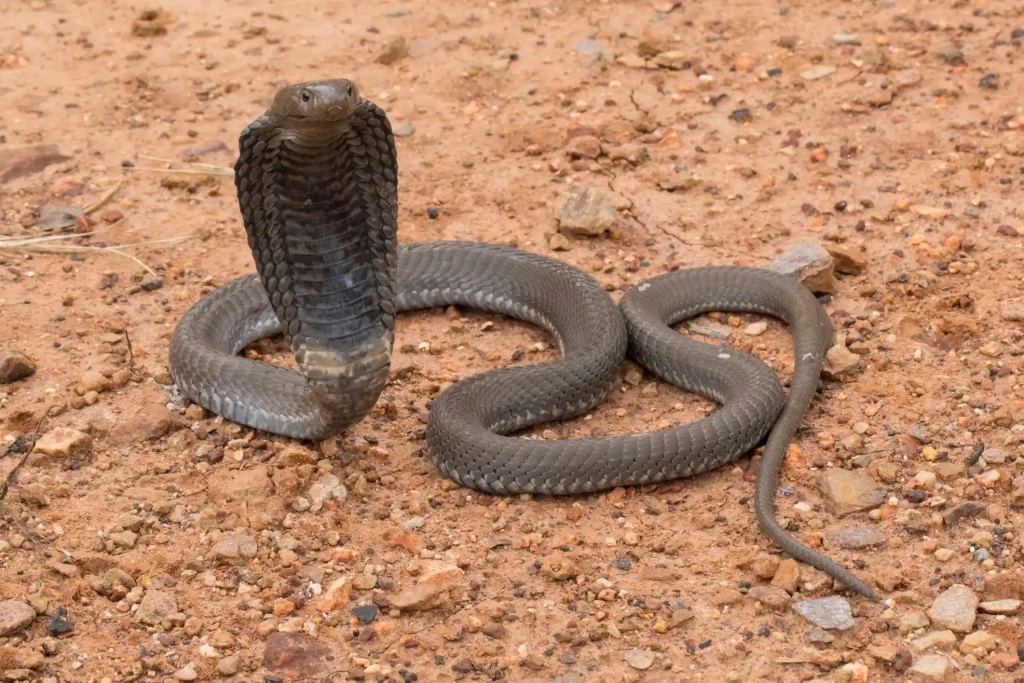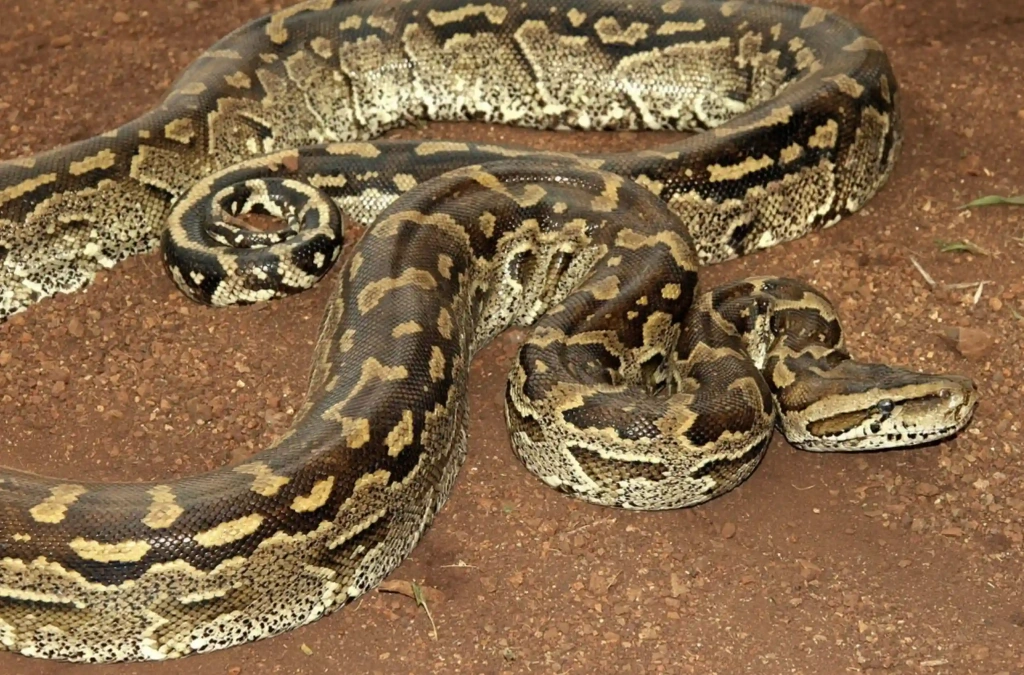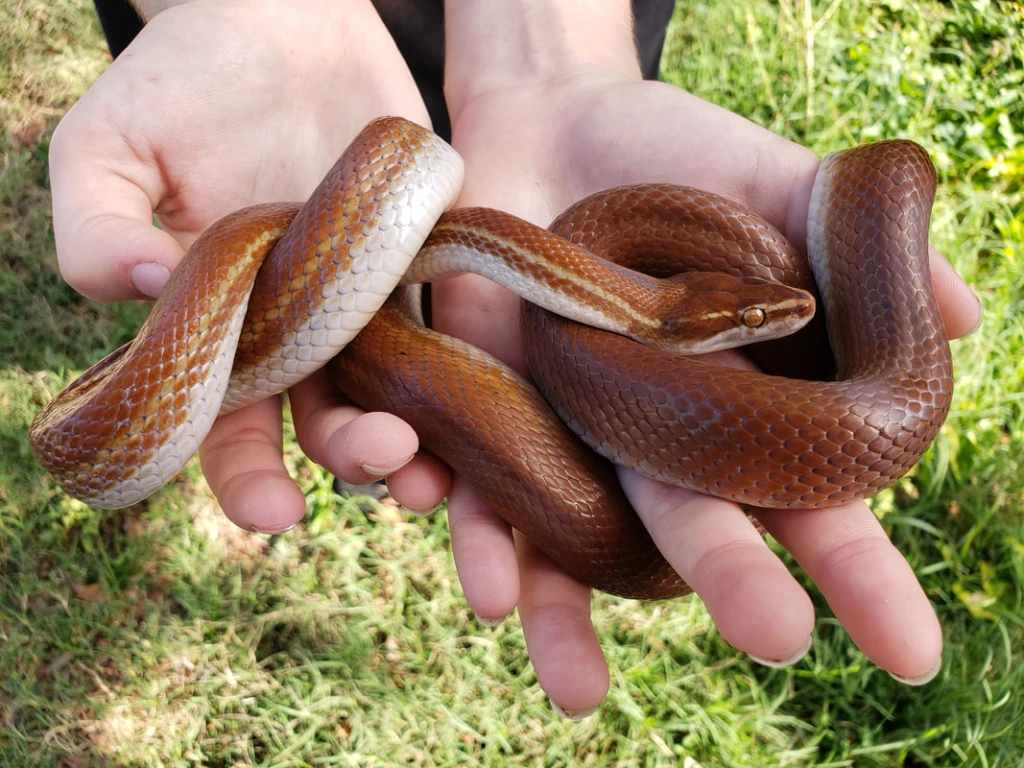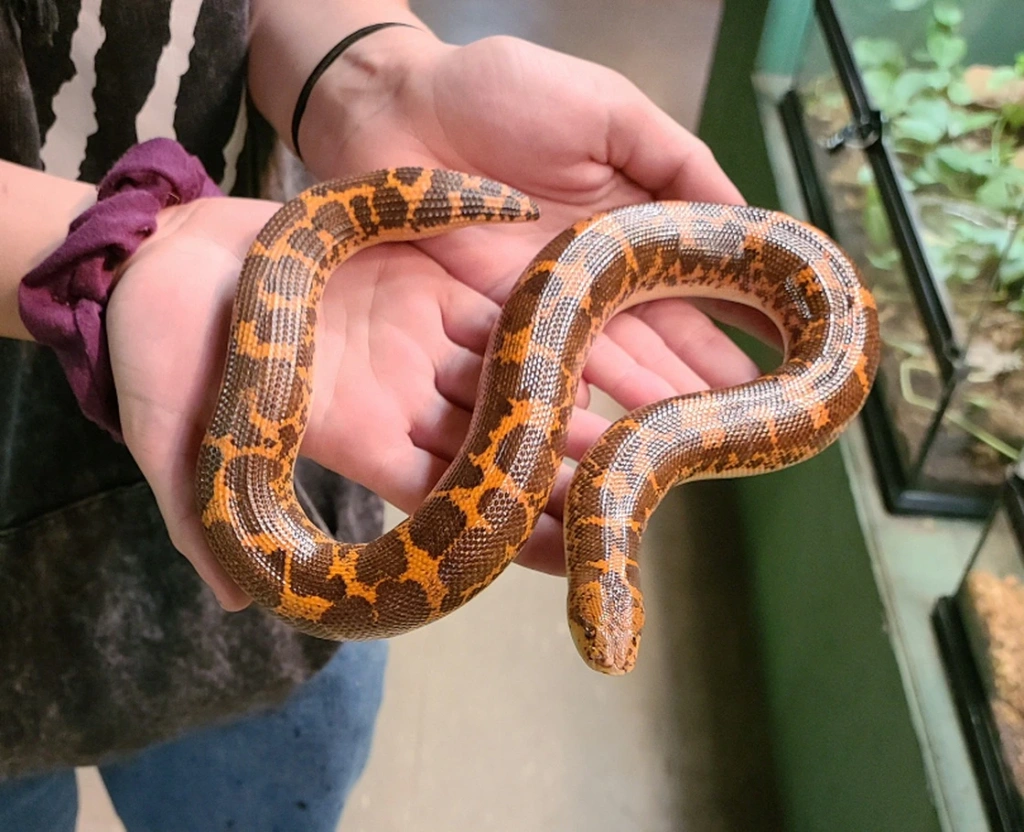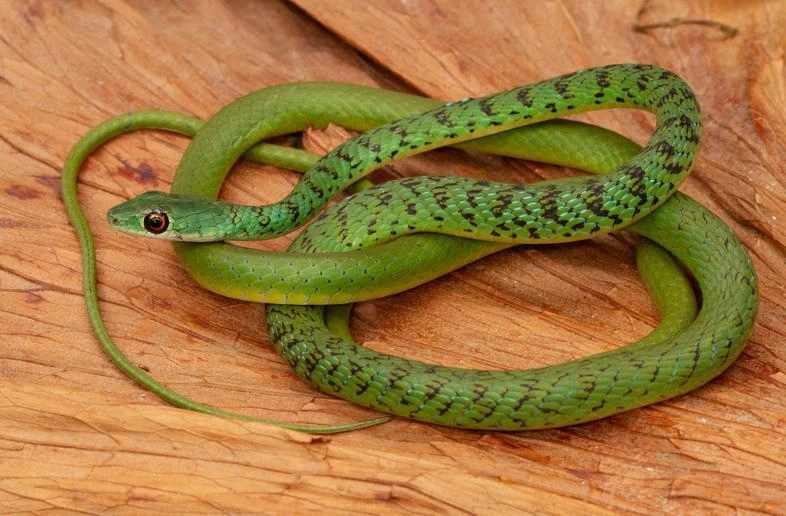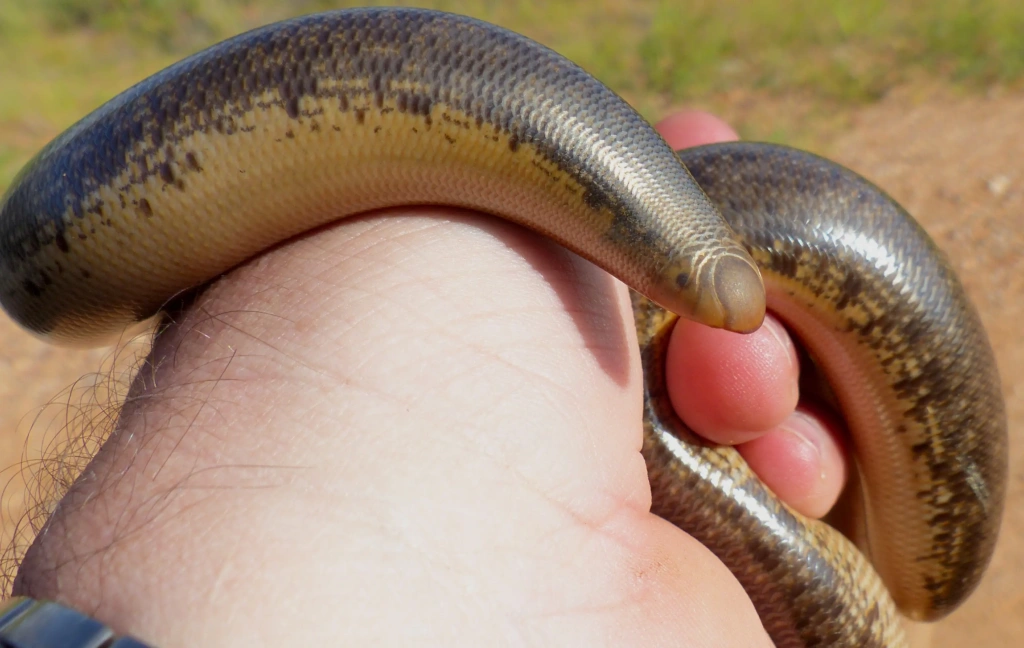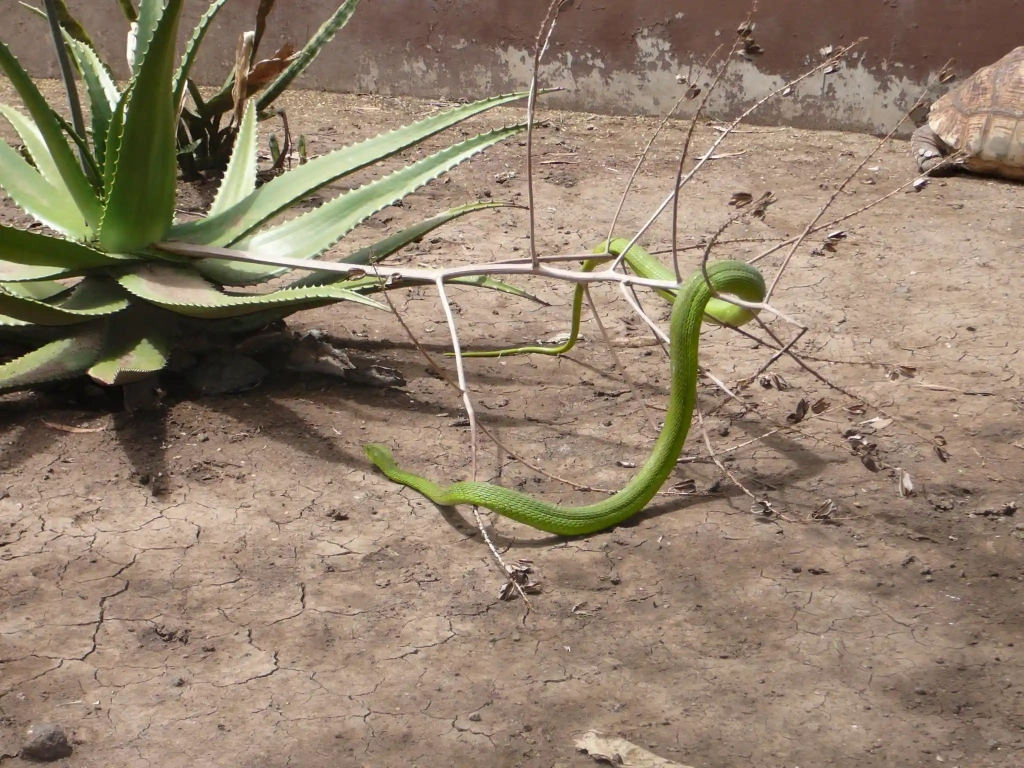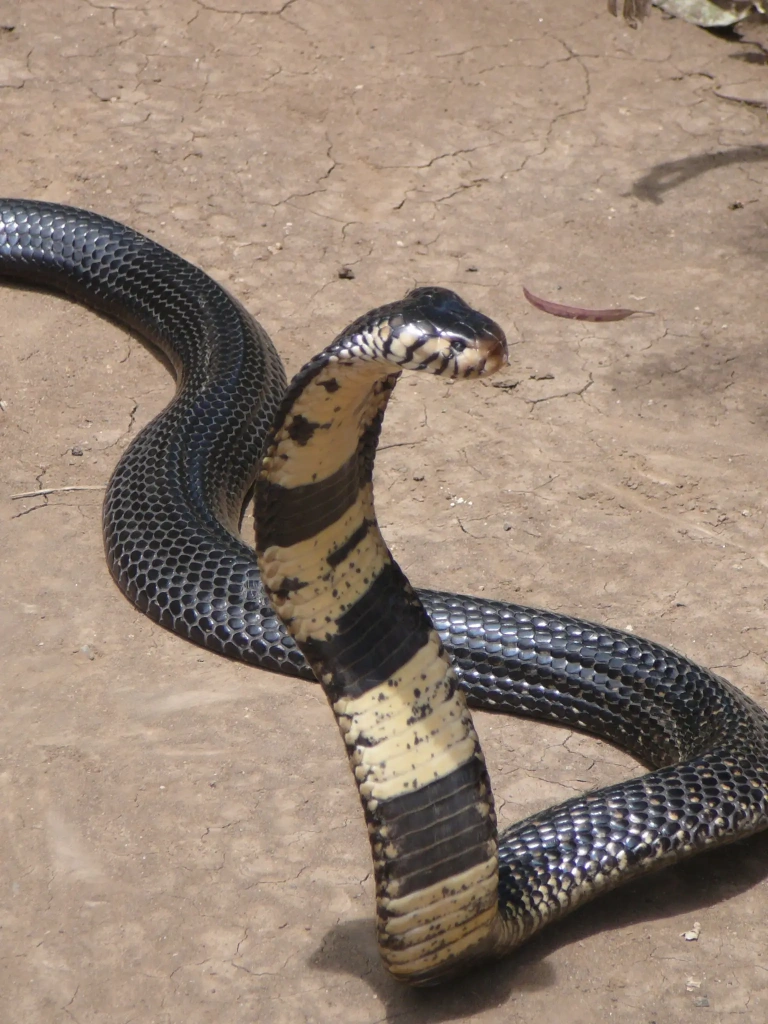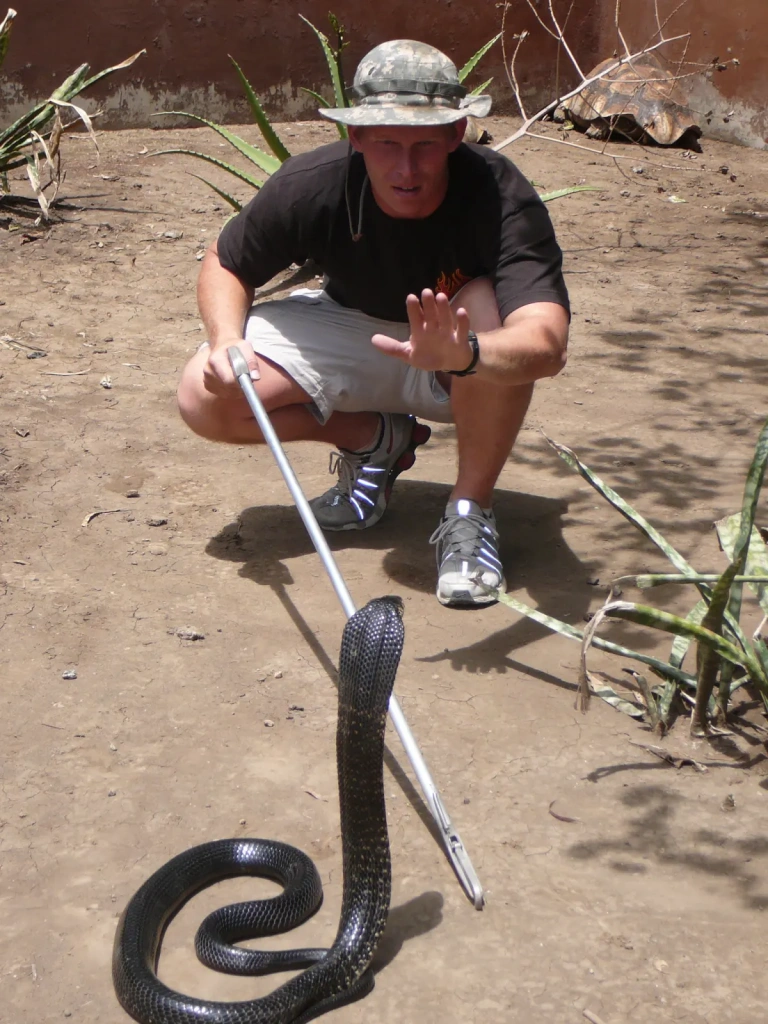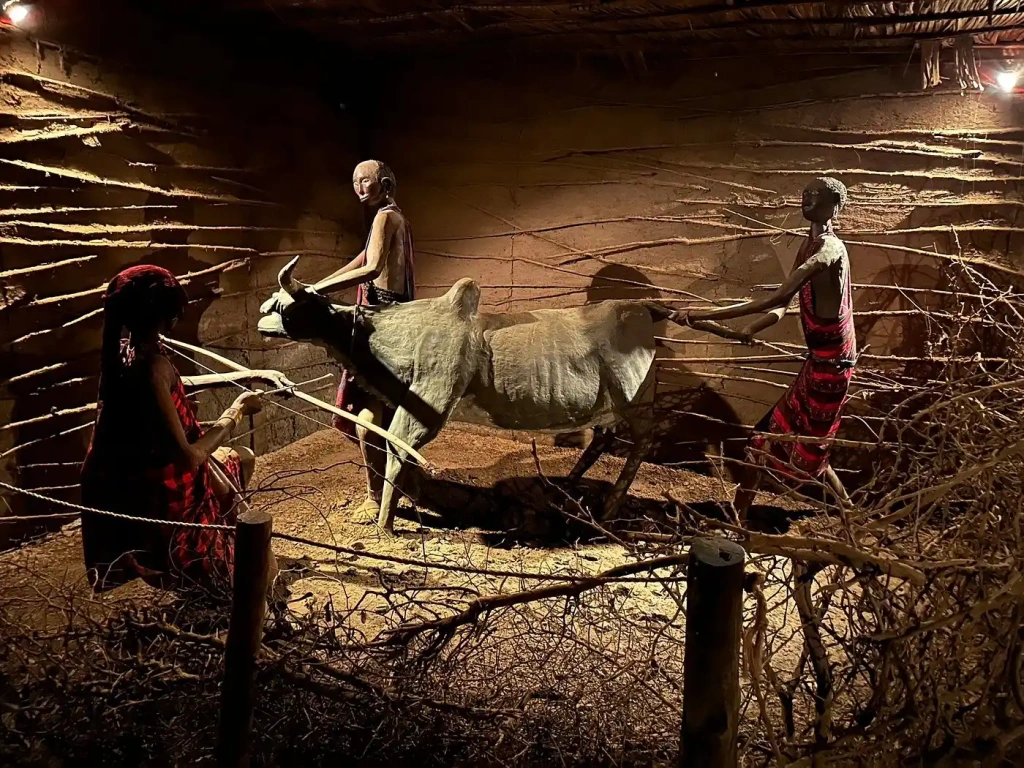Every exotic destination has its unique wildlife, but not all of it inspires awe or affection. In the hot, tropical climate of East Africa, some creatures have a somewhat notorious reputation. For many travelers, even the idea of running into a snake is enough to spark a wave of anxiety.
Don’t worry — while snakes do live in Tanzania, it’s rare to see one. Fewer than 10% of the species found here pose any real threat to humans. The vast majority are entirely harmless, go out of their way to avoid people, and are far more likely to spook you than cause any actual harm.
In this guide, we’ll introduce you to some of the most fascinating and unusual snake species in Tanzania. You’ll learn which ones are venomous, which are harmless, and how to tell the difference. And for reptile enthusiasts, we’ll let you know where you can safely observe these creatures up close in a controlled environment.
Black Mamba
Length: 200–450 cm (6.6–14.8 ft)
Color: brown, olive, or yellow. Some rare individuals have black coloring with purple scales.
Venomous: yes.
The black mamba (Dendroaspis polylepis) prefers nesting in burrows and typically inhabits lightly wooded areas with sparse shrubs, rocky outcrops, or semi-arid savannas. It is far less commonly found in lowland forests or near villages.
Interestingly, the snake got its name not from its coloration, but from the deep black color of the mucous membranes inside its mouth. Its deadly venom quickly attacks the nervous and cardiovascular systems. Within 10 minutes of a bite, a person may have trouble breathing, suffer severe headaches, and experience paralysis. The black mamba is also very fast, capable of moving at speeds of up to 16 km/h (10 mph) and striking its target, whether prey or what it perceives as a threat.
Despite its deadly nature, this snake is quite timid. When it encounters a person, it will usually try to escape—unless it feels cornered. When threatened, it raises its head and hisses loudly as a warning to its opponent.
Green Mamba
Length: 180–200 cm (5.9–6.6 ft)
Color: green.
Venomous: yes.
The eastern green mamba (Dendroaspis angusticeps), also known as the narrow-headed mamba, is primarily found along the coastal regions of southeastern Africa, particularly in humid tropical and montane forests. It was first described in 1849 by Scottish surgeon and zoologist Andrew Smith, who rightfully noted that the species is “shy and elusive.”
The green mamba is an expert tree climber and blends seamlessly into the foliage. With its narrow body, vivid green color, and elongated head, it closely resembles a vine. That’s why you should be cautious when reaching for branches — you could disturb one of Africa’s most dangerous snakes. The inside of the green mamba’s mouth, unlike the black mamba’s, is white or bluish.
The green mamba is solitary by nature, but unlike many other reptiles, it prefers to hunt during the day. It almost always stays in the trees and rarely comes down to the ground.
Timid and skittish by nature, green mambas go out of their way to avoid contact with humans or large predators. When they sense danger, they either blend into their surroundings or quickly retreat, moving at speeds of up to 11 km/h (6.8 mph). Of the three mamba species, the green mamba has the weakest venom, but it’s still potentially lethal. During an attack, it may strike multiple times. The bite typically causes swelling and pain at the site, and symptoms can include difficulty breathing, vomiting, and severe convulsions. Paralysis, however, is extremely rare.
If you're curious about how mambas are captured in Africa when they wander into populated areas, we recommend checking out this video by National Geographic.
African Puff Adder
Length: 100–150 cm (3.3–4.9 ft)
Color: gray or brownish with yellow spots on the back and a dark stripe across the top of the head and between the eyes.
Venomous: yes.
The African puff adder (Bitis arietans) is commonly found in savannas, open grasslands, and, unfortunately, in populated areas close to villages and farmland. It earned its name from its distinctive defense behavior: when threatened, it puffs up its body and emits a loud hiss before launching a strike.
The puff adder may move slowly, but its striking pattern helps it blend in on the ground and among rocky terrain, its preferred environment. Despite its sluggish reputation, it’s also a strong swimmer and a surprisingly good climber. In fact, one puff adder was once discovered 4.6 meters (15 feet) off the ground, hidden in the thick foliage of a tree canopy.
Vipers are carnivores that prey on small mammals, birds, frogs, turtles, and lizards. They don’t attack humans without provocation, but if they feel threatened, their bite can be extremely dangerous, or even fatal. While primarily nocturnal hunters, vipers are sometimes seen during the day, especially when basking in the sun.
The African puff adder is rightfully called one of the most dangerous snakes in Tanzania. Its venom contains powerful cytotoxins that, once in the bloodstream, can cause intense pain, severe swelling, and rapid tissue destruction around the bite site. Victims often experience symptoms such as excruciating headaches, nausea, vomiting, and profuse bleeding. Without prompt medical treatment, the venom can kill a healthy adult within 24 hours.
However, like the vast majority of snakes, even the most dangerous ones, the puff adder doesn’t seek out humans to attack. A venomous bite is purely a defensive reaction, used when the snake feels cornered.
Boomslang
Length: 100–160 cm (3.3–5.2 ft), up to 2 meters (6.6 ft) maximum.
Color: males are usually light green with black and blue scales, while females are brown.
Venomous: yes.
The boomslang (Dispholidus typus) resembles a cartoon character, with its bright green body featuring striking black markings and oversized black eyes with lime-green irises. This vivid coloration serves as effective camouflage, allowing the snake to blend into the leafy canopy of tropical forests as it lies in wait for prey.
The boomslang’s unusual name comes from Afrikaans, once considered a Dutch dialect and now one of South Africa’s 11 official languages. In Afrikaans, boomslang translates literally to “tree snake.”
Despite its striking appearance, the boomslang is highly venomous, and a single bite can be fatal. However, its venom acts slowly, so severe symptoms may not appear right away. This delayed onset can create a false sense of security, but it’s crucial to seek medical help immediately after a bite. The venom contains a potent hemotoxin that prevents blood from clotting, meaning a person can die from severe blood loss.
When threatened, the boomslang will freeze briefly, then shake its head from side to side as a warning. Despite this display, it rarely attacks humans and usually chooses to flee instead.
However, boomslangs lay their eggs not only in tree hollows but also on the ground under leaves and decaying logs. So when you’re walking through a tropical forest, it’s important to stay alert, as any snake will fiercely defend its eggs.
Egyptian Cobra
Length: 140–259 cm (4.6–8.5 ft)
Color: brown is the most common, but red, gray, and black variations can also be found.
Venomous: yes.
The Egyptian cobra (Naja haje), also called the brown cobra, has a broad, flattened head that seamlessly expands into a “hood” that flares when threatened. This iconic feature is common among most elapid snakes. It mainly lives near shallow waters and often nests in abandoned burrows of small animals.
The venom of the Egyptian cobra contains a mix of neurotoxins and cytotoxins that target the nervous system, eventually causing respiratory failure and death. While extremely potent, the venom acts slowly. Early symptoms include intense swelling and tissue necrosis around the bite, followed by stomach pain, vomiting, diarrhea, and convulsions. Unlike some of its African cousins, this cobra does not spit its venom.
These snakes are typically nocturnal and tend to steer clear of humans. However, they may occasionally venture into populated areas while searching for food. Their diet mainly consists of lizards, frogs, birds, and even other snakes. If they come across a person, they usually try to escape rather than confront.
Black-necked Spitting Cobra
Length: 1–2 meters (3.3–6.6 feet)
Color: varies depending on the morph. Some individuals are black or gray with distinctive pink neck stripes and reddish bellies. Others may be light brown or yellow and lack any striping. There are also white morphs, which can have dark eyes and either black body stripes or no stripes at all.
Venomous: yes.
The black-necked spitting cobra (Naja nigricollis) inhabits savannas near streams and rivers. It often takes shelter in trees, abandoned burrows of small animals, or old termite mounds, its preferred places to rest and cool off.
This species is one of the few snakes adapted to an active lifestyle both during the day and at night. This trait gives the spitting cobra a greater advantage in hunting and locating food. It’s also known for its persistence, often tracking small vertebrate prey over extended periods. In addition, it has a taste for bird eggs, which it skillfully finds in trees.
Unlike the Egyptian cobra, this species can spit venom, reaching distances of up to 7 meters (23 feet). The venom is aimed at the eyes and can blind anything that threatens it. A bite from this cobra leads to intense pain, significant swelling, and sometimes paralysis of the affected limb. While fatalities are possible, they are relatively rare, even without medical treatment.
In 1944, English ophthalmic surgeon Harold Ridley published a brief article in the British Journal of Ophthalmology detailing the composition and effects of spitting cobra venom. Drawing from his firsthand experience in West Africa, Ridley described a case of venom-induced ophthalmia. The patient, Gogi Kusasi, a 30-year-old laborer, encountered a black-necked spitting cobra while mowing grass. The snake’s venom struck Kusasi’s right eye, leading to temporary blindness. Remarkably, Ridley was able to fully restore the man’s vision.
Later, after studying the therapeutic properties of snake venom, Dr. Ridley proposed that it could be used in lower concentrations as an effective pain reliever, including in ophthalmic surgeries.
«Mankind in general has a loathing of snakes that it is surprising to discover the extensive literature on the beneficial uses of their venom. Cobra venom has been used as an analgesic for the relief of pain in tabes, cancer, angina pectoris, trigeminal neuralgia, etc. It also relieves the pain in herpes zoster without, however, modifying the course of the disease.». Harold Ridley, 1944, British Journal of Ophthalmology
African rock python
Length: 350–750 cm (11.5–24.6 ft)
Color: yellow-brown with striped spots of olive, beige, or sand color. Has a yellow inverted “V” under the eyes.
Venomous: no.
The African rock python (Python sebae), also known as the hieroglyphic python, is one of the largest snake species in Tanzania and throughout East Africa. Its range includes a wide variety of habitats, such as near rivers and lakes, in forests, savannas, swamps, and even semi-desert regions. In Tanzania, it can be spotted in the Serengeti National Park.
While the python isn’t venomous, it's best admired from a distance, as this snake can easily take down prey as large as a monkey or even a gazelle, constricting it with incredible muscular strength before swallowing it whole.
Moreover, female African rock pythons are known to guard their nests and newly hatched young fiercely. If one appears to strike without warning, it’s likely because her nest is nearby — the mother’s simply acting out of instinct to protect her offspring.
This python can weigh between 45 and 55 kg (99–121 lbs) and live up to 30 years. It preys on fairly large mammals, using special heat-sensitive pits to detect them. Interestingly, it has two lungs, unlike some snake species that have only one, and small pelvic spurs, which some biologists believe are remnants of hind limbs.
Central African rock pythons are solitary by nature, typically coming into contact with others of their species only during mating season. While they primarily move along the ground, they’re also skilled climbers and swimmers, able to stay submerged for extended periods. In the dry season, they enter a state of dormancy, similar to hibernation.
House Brown Snake
Length: 60–120 cm (2–4 ft)
Color: ranges from yellow to brown and brick red. The head features two white stripes, and the belly is a cream-white color with stripes running along the body.
Venomous: no.
African house snakes (Boaedon capensis) are commonly found in tall grasses and around suburban areas. True to their name, they’re known to occasionally wander into homes in search of food like small rodents, lizards, or birds. But there’s no cause for concern as these snakes are completely harmless.
While female house snakes can reach lengths of up to 1.5 meters (4.9 ft), males typically do not exceed 60 cm (2 ft) in length. They are mainly active at night, moving slowly and silently to avoid startling their prey. Since they are non-venomous, their only means of immobilizing their catch is by constricting it with their muscles.
There are even rumors that rural Tanzanians intentionally keep house snakes to hunt mice, much like cats. In reality, these are just rumors and nothing more.
African house snakes are a popular choice among exotic pet owners thanks to their small size, ease of care, and generally calm temperament. That said, it’s best to keep them in separate enclosures. In the wild, they typically breed twice a year, but in captivity, the number of breeding cycles can increase to six times. One female can lay anywhere from 10 to 40 eggs at a time.
Kenyan Sand Boa
Length: 30–91 cm (12–36 in)
Color: yellow-orange with dark brown spots, white or cream-colored belly.
Venomous: no.
The Kenyan sand boa (Eryx colubrinus) is a unique species native to northern and eastern Africa. Short and stout, this snake has a small head, vertical pupils, and a body covered in smooth scales — except for the tip of its tail, which features tiny bumps. Utterly harmless to humans, it’s a favorite among exotic reptile enthusiasts.
In the wild, Kenyan sand boas favor semi-desert regions and shrub-covered savannas. They’re also occasionally found on rocky outcrops and even in farmland, but their ideal habitat is loose, sandy soil. These snakes are primarily burrowers, often hiding beneath rocks or in abandoned animal burrows to escape the heat. At the same time, they are excellent climbers and can occasionally be found in dense tree canopies.
Kenyan sand boas are mostly nocturnal, but they occasionally venture into open areas during the day. They prey on small animals like rodents, lizards, and birds. Since they’re non-venomous, they rely entirely on their muscular strength to capture and kill their food.
In the wild, Kenyan sand boas typically live 10 to 20 years, but in captivity, they can live up to 30 years. Their small size, striking coloration, and low-maintenance care make them a favorite among exotic pet enthusiasts. Most importantly, they’re completely harmless to humans, so even if you spot one in the wild, there’s no reason to be afraid.
Spotted Bush Snake
Length: 60–130 cm (2–4.3 ft)
Color: yellow, green, or blue with black spots and stripes. The tail tip may have a brownish tint.
Venomous: no.
The spotted bush snake (Philothamnus semivariegatus) is mainly found in Tanzania’s forested regions. It’s an expert climber, skillfully navigating tree branches, scaling walls, and even swimming. Its impressive agility comes from the keeled scales on the underside of its body. This snake stands out with its bright green spotted pattern, striking golden-yellow eyes, and a blue tongue.
The spotted bush snake is often mistaken for the much more dangerous venomous mamba, but unlike the latter, it is completely harmless to humans. These snakes mainly hunt lizards, geckos, and frogs during the day. They’re patient predators, often remaining still for long stretches as they quietly stalk their prey.
Bush snakes are quick and nervous creatures. At the slightest hint of danger, they dart away, so spotting one in the wild is truly a lucky find. They don’t stick to a specific habitat and can cover large distances, especially when chasing prey. Locals in Tanzania say if you come across one of these harmless green snakes in your home, just leave the windows open — they’ll find their way out soon enough.
Schlegel's beaked blind snake
Length: 10–95 cm (4–37 in)
Color: varies by morph. Some individuals have a uniform color ranging from black to brown with a yellowish belly. Spotted morphs typically have irregular black or dark brown spots on their back and yellow-green spots on their belly and sides. Striped morphs have scales edged in black.
Venomous: no.
Schlegel’s blind snake (Afrotyphlops schlegelii) is one of the most unusual reptiles you might encounter in East or Southern Africa. Endemic to this part of the continent, it isn’t found anywhere else in the world. A member of the blind snake family (Typhlopidae), it closely resembles a large earthworm.
This snake is harmless to humans and feeds primarily on termites. It spends most of its life underground, only rarely emerging at the surface. Its unusual appearance is well adapted to this lifestyle: it has tiny, reduced eyes covered by protective scales, a body that narrows toward the head and is covered in small, uniform scales, and a short spine at the tip of its tail, which it uses to push through soil as it burrows.
Interestingly, as recently as the early 20th century, this species was classified as a legless lizard. It was later reclassified as a snake, but many modern biologists still view it as more closely related to lizards. This perspective is based on several well-documented anatomical traits that set it apart from actual snakes.
Meserani Snake Park: a place to see Tanzania’s exotic snakes
For those curious about East Africa’s exotic reptiles, the Meserani Snake Park in Tanzania is well worth a visit. It is conveniently located just a 40-minute drive (25 km / 15.5 miles) from Arusha, right along the route to the Tarangire National Park and the Ngorongoro Crater.
The park was established in 1993 by a group of passionate conservationists from South Africa to promote snake conservation in Tanzania. Its prime location on a busy tourist route makes it a common stop for many tours. Covering an area just over 40,000 m² (430,556 sq ft), the park features lush tree groves, spacious snake enclosures, the Maasai Culture Museum, and a clinic.
The park employs approximately 50 local residents and actively supports the surrounding community. Its initiatives include providing free medical care, maintaining an animal shelter, and engaging in charitable projects. Notably, the Meserani Snake Park has funded the construction of new classrooms for a local school and established an adult education center.
Meserani Snake Park is a great place to learn about East Africa’s native reptiles. Currently, more than 30 species of snakes can be seen here, including pythons, cobras, vipers, and mambas. During the tour, you will receive detailed information about the behavioral traits of each species, their habitats, and the roles they play within the ecosystem.
As mentioned earlier, the park also includes the Maasai Culture Museum, where a local Maasai guide leads tours. Additionally, the park houses a free education center for local residents.
After a day full of activities, you can unwind in the park’s modern recreation area, complete with a barbecue and bar. For many years, the Meserani Bar was a favorite hangout for travelers and a point of pride for the park, earning a reputation that extended well beyond East Africa. In recent years, however, its popularity has declined somewhat, as most tourists now explore Tanzania through organized tours, with fewer independent travelers embarking on adventurous solo trips across the continent.
The entrance fee to the snake park is around $20. However, it's best to confirm the current price directly with the administration before your visit.
Contact information:
- Phone: +255 754 440 800
- Email: [email protected]
- Social media: Facebook
The Meserani Snake Park Clinic (MSPC) is a crucial part of the park, offering free emergency treatment for snake bites to anyone in need. The clinic treats around 1,000 patients every month at no cost. It’s funded by proceeds from the Maasai Culture Museum and donations from various charitable organizations. For instance, Altezza Travel sponsored a year’s supply of antivenom for MSPC, valued at €7,500.
In conclusion
Tanzania is home to only a handful of truly dangerous snakes. Most of these reptiles lead secretive lives and do their best to avoid people. Even venomous snakes don’t actively hunt humans and only strike if they feel threatened.
At the same time, Tanzanian snakes play a crucial role in maintaining the balance of ecosystems, despite their intimidating appearance. Recognizing this, the Ruaha National Park launched its first large-scale snake research program in 2024 to study species diversity and behavior. Interestingly, the park is also home to one of Tanzania’s most dangerous reptiles — the boomslang, which we covered earlier.
There’s no need to fear snakes. Just follow common sense and observe basic safety precautions. That way, nothing will prevent you from fully enjoying your travels in Tanzania.
All content on Altezza Travel is created with expert insights and thorough research, in line with our Editorial Policy.
Want to know more about Tanzania adventures?
Get in touch with our team! We've explored all the top destinations across Tanzania. Our Kilimanjaro-based adventure consultants are ready to share tips and help you plan your unforgettable journey.
















